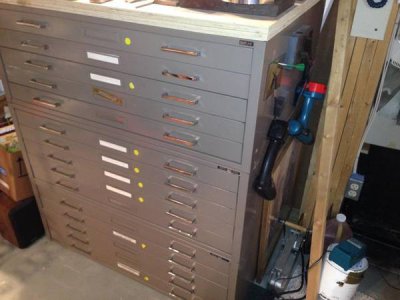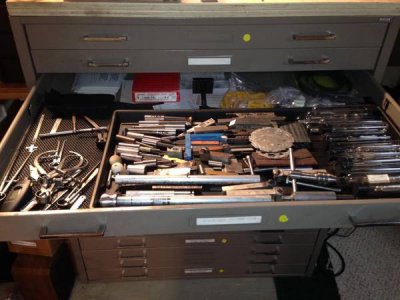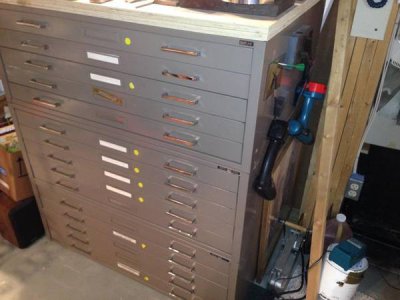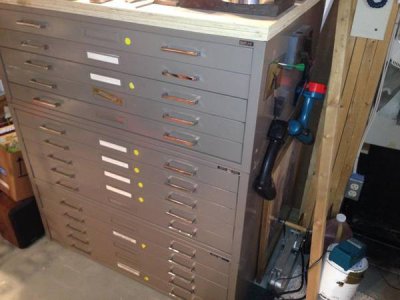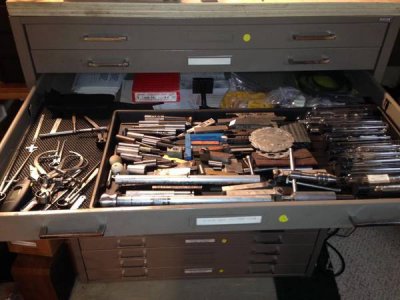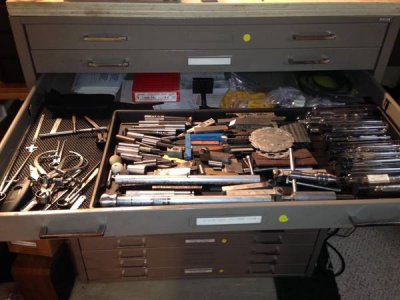I'm going to make a large tool chest. Why buy when you can build. I need a few ideas on sheet metal gauge and what draw slide to use. In the process of building a metal break so I'll need a project when I'm finished. Bending the draws looks challenging. Anybody tried a project like this, give me some hints.
-
Welcome back Guest! Did you know you can mentor other members here at H-M? If not, please check out our Relaunch of Hobby Machinist Mentoring Program!
You are using an out of date browser. It may not display this or other websites correctly.
You should upgrade or use an alternative browser.
You should upgrade or use an alternative browser.
Making a metal tool chest, need ideas.
- Thread starter farmer
- Start date
- Joined
- Jul 20, 2012
- Messages
- 1,244
- Joined
- Dec 6, 2012
- Messages
- 2,677
Are you building a finger brake? It might be handy for the drawers. Do you have a shear?
My 24" Diacros will take up to 16ga.
According to Mapquest Kirkman Iowa is 5hours 36min to Dayton MN.
Come on up. Shear it here and brake as needed assemble back in Kirkman (no charge!).
Just a thought.
Daryl
MN
My 24" Diacros will take up to 16ga.
According to Mapquest Kirkman Iowa is 5hours 36min to Dayton MN.
Come on up. Shear it here and brake as needed assemble back in Kirkman (no charge!).
Just a thought.
Daryl
MN
- Joined
- Jul 20, 2012
- Messages
- 1,244
A spot welder is going to be real handy for those sheet metal projects. There is one at Harbor Freight that is inexpensive and works ok. Maybe find one online.
- Joined
- Sep 28, 2013
- Messages
- 4,319
mill it from billet? Complete waste of time and material, but boy that would be a neat punch line when you're showing it off 
- Joined
- Apr 23, 2011
- Messages
- 2,476
We make a lot of things that could be bought elsewhere, cheaper & easier. But thats not really the point. Its the satisfaction of building something with your hands, sometimes from nothing.
Without knowing, the OP may have a bunch of sheet steel already, or access to a cheap source.
Cheers Phil
Without knowing, the OP may have a bunch of sheet steel already, or access to a cheap source.
Cheers Phil
- Joined
- May 20, 2014
- Messages
- 191
Well, this brings back memories. I worked a short stint at an industrial sheet metal shop, mostly govt/military contracts, making chests, cabinets, lockers. This place was HUGE, like a Boeing hangar. We went through hundreds of tons of sheet metal, mostly 18 guage, some 20 and 16.
A few thoughts come to mind.
One of the major challenges is proper preplanning, especially material allowance in bends. Material allowance for drawings done in Outside Dims is different for Inside Dims, and is defined by material thickness and bend radius.
Another design challenge is preplanning flaps/overlaps. The clearance features of the industrial brakes (some 16' wide), and finger design/depth (throats up to 2'-3'), defined the go/no-go rules of side/flap/overlap dimension limits.
Each bend had its own dedicated machine setup. As such, one machine would do that bend, then the sheet would progress down the line for the next bend, and etc. Too many bends, not enough machines, stock would need a place to pile-up before returning for next sequence of bends. We're talking hundreds of sheets here.
A prototype sheet would go through the process. Engineers and draftsman would measure and confirm dims and machine setup at every stage of the process, tweaking the dims and specs as needed. Sometimes would require altering the sequence because one operation would interfere with some other process down the line.
Sheet metal is sharp. The sheet, as supplied, was oily. Some of us wore a special suction cup on a finger, like a wedding ring, to handle/separate the sheets. I don't recall anyone wearing gloves, but I DO recall some fellows with less than 10 fingers. I still have my own battle scars.
All brake processes were done by teams of at least 2 people. One person at each side of the sheet would ensure proper seating of his side to the depth stops before both would agree to stomp the foot bar, and each would support the outboard end as the metal would form (usually swinging violently upward). This 'buddy' system produced quality bends, and improved safety.
For your project, I suppose the important parts would be:
Elaborate pre-planning (dimensions and sequencing).
Meticulous setup for each bend, perform all these bends (like for multiple drawers) in groups.
Ensure that drawer bottoms will support the expected loads without bending to drag on the lower drawer. May need to include a folded-V stiffener bend, or a separate divider/stiffener.
If you're good, the fronts of your drawers will be perfectly squared and spaced equally. If you're like me, you could use the cabinetmakers method of letting the imperfect front be a base for a separate faceplate that would be fitted after the drawers are installed, setting it in place to get those nice/even spaces...
A few thoughts come to mind.
One of the major challenges is proper preplanning, especially material allowance in bends. Material allowance for drawings done in Outside Dims is different for Inside Dims, and is defined by material thickness and bend radius.
Another design challenge is preplanning flaps/overlaps. The clearance features of the industrial brakes (some 16' wide), and finger design/depth (throats up to 2'-3'), defined the go/no-go rules of side/flap/overlap dimension limits.
Each bend had its own dedicated machine setup. As such, one machine would do that bend, then the sheet would progress down the line for the next bend, and etc. Too many bends, not enough machines, stock would need a place to pile-up before returning for next sequence of bends. We're talking hundreds of sheets here.
A prototype sheet would go through the process. Engineers and draftsman would measure and confirm dims and machine setup at every stage of the process, tweaking the dims and specs as needed. Sometimes would require altering the sequence because one operation would interfere with some other process down the line.
Sheet metal is sharp. The sheet, as supplied, was oily. Some of us wore a special suction cup on a finger, like a wedding ring, to handle/separate the sheets. I don't recall anyone wearing gloves, but I DO recall some fellows with less than 10 fingers. I still have my own battle scars.
All brake processes were done by teams of at least 2 people. One person at each side of the sheet would ensure proper seating of his side to the depth stops before both would agree to stomp the foot bar, and each would support the outboard end as the metal would form (usually swinging violently upward). This 'buddy' system produced quality bends, and improved safety.
For your project, I suppose the important parts would be:
Elaborate pre-planning (dimensions and sequencing).
Meticulous setup for each bend, perform all these bends (like for multiple drawers) in groups.
Ensure that drawer bottoms will support the expected loads without bending to drag on the lower drawer. May need to include a folded-V stiffener bend, or a separate divider/stiffener.
If you're good, the fronts of your drawers will be perfectly squared and spaced equally. If you're like me, you could use the cabinetmakers method of letting the imperfect front be a base for a separate faceplate that would be fitted after the drawers are installed, setting it in place to get those nice/even spaces...
- Joined
- Dec 6, 2012
- Messages
- 2,677
I'm certainly no expert, as I seem to make more interesting shapes unrelated to my project than I do useable product.
But, I've found this free on-line document helpful in bending sheet.
http://www.micro-machine-shop.com/Sheet Metal Bending.pdf
Daryl
MN
But, I've found this free on-line document helpful in bending sheet.
http://www.micro-machine-shop.com/Sheet Metal Bending.pdf
Daryl
MN
- Joined
- Jul 20, 2012
- Messages
- 1,244
I like the idea of working on the tool chest, would be useful and rewarding.
One idea would be not to work on the actual drawer cabinets but work on an overall cabinet that would include your boxes you already have or some sets of drawer toolboxes already made you buy. In the end you would make a stand up custom box that would hold the other boxes inside. So closed looks like a solid box, maybe with wheels. (Like you sometimes see a pro auto mechanic has for their tools.) When open the top comes up, maybe has a light on it focussed on the bench top custom built right there, cabinets above, side, below as you want it.
Then from there you could work on other custom but matching cabinets "Toolboxes" for other tools you have out of sheet metal.
Would look like a slick shop with nicely painted and matching tool storage.
One idea would be not to work on the actual drawer cabinets but work on an overall cabinet that would include your boxes you already have or some sets of drawer toolboxes already made you buy. In the end you would make a stand up custom box that would hold the other boxes inside. So closed looks like a solid box, maybe with wheels. (Like you sometimes see a pro auto mechanic has for their tools.) When open the top comes up, maybe has a light on it focussed on the bench top custom built right there, cabinets above, side, below as you want it.
Then from there you could work on other custom but matching cabinets "Toolboxes" for other tools you have out of sheet metal.
Would look like a slick shop with nicely painted and matching tool storage.


